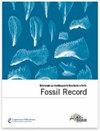Jason A. Dunlop, Christian Bartel, Plamen G. Mitov
下载PDF
{"title":"An enigmatic spiny harvestman from Baltic amber","authors":"Jason A. Dunlop, Christian Bartel, Plamen G. Mitov","doi":"10.1002/mmng.201200007","DOIUrl":null,"url":null,"abstract":"<p>A new harvestman (Arachnida: Opiliones) from Baltic amber (Palaeogene: Eocene; ca. 44–49 Ma) is described as <i>Piankhi steineri</i> n. gen., n. sp. This enigmatic fossil expresses long, slender pedipalps without a tarsal claw, which is characteristic for the suborder Dyspnoi. The chelicerae are notably enlarged and the dorsal body surface is formed from a carapace with a separate prosomatic tergite (<i>metapeltidium</i>), plus a large opisthosomal scute (or <i>scutum parvum</i>). However these characters, combined with the distinctly spiny limbs and further rows of spines across the fossil's opisthosoma, have no parallel among the modern dyspnoid harvestmen that we are aware of. The fossil resolves features reminiscent of modern members of the dyspnoid families Ceratolasmatidae, Nipponopsalididae, Ischyropsalididae and Sabaconidae, but does not show unequivocal apomorphies of any one particular family. We must entertain the possibility that this is an extinct body plan from the Eocene of north-central Europe, and we tentatively refer the fossil to a new genus in an unresolved position among the Ischyropsalidoidea (Dyspnoi). An amorphous triangular structure behind the anal region is assumed to be faecal matter, rather than part of the original anatomy. (© 2012 WILEY-VCH Verlag GmbH & Co. KGaA, Weinheim)</p>","PeriodicalId":55147,"journal":{"name":"Fossil Record","volume":"15 2","pages":"91-101"},"PeriodicalIF":2.1000,"publicationDate":"2012-08-03","publicationTypes":"Journal Article","fieldsOfStudy":null,"isOpenAccess":false,"openAccessPdf":"https://sci-hub-pdf.com/10.1002/mmng.201200007","citationCount":"2","resultStr":null,"platform":"Semanticscholar","paperid":null,"PeriodicalName":"Fossil Record","FirstCategoryId":"89","ListUrlMain":"https://onlinelibrary.wiley.com/doi/10.1002/mmng.201200007","RegionNum":4,"RegionCategory":"地球科学","ArticlePicture":[],"TitleCN":null,"AbstractTextCN":null,"PMCID":null,"EPubDate":"","PubModel":"","JCR":"Q3","JCRName":"Earth and Planetary Sciences","Score":null,"Total":0}
引用次数: 2
引用
批量引用
Abstract
A new harvestman (Arachnida: Opiliones) from Baltic amber (Palaeogene: Eocene; ca. 44–49 Ma) is described as Piankhi steineri n. gen., n. sp. This enigmatic fossil expresses long, slender pedipalps without a tarsal claw, which is characteristic for the suborder Dyspnoi. The chelicerae are notably enlarged and the dorsal body surface is formed from a carapace with a separate prosomatic tergite (metapeltidium ), plus a large opisthosomal scute (or scutum parvum ). However these characters, combined with the distinctly spiny limbs and further rows of spines across the fossil's opisthosoma, have no parallel among the modern dyspnoid harvestmen that we are aware of. The fossil resolves features reminiscent of modern members of the dyspnoid families Ceratolasmatidae, Nipponopsalididae, Ischyropsalididae and Sabaconidae, but does not show unequivocal apomorphies of any one particular family. We must entertain the possibility that this is an extinct body plan from the Eocene of north-central Europe, and we tentatively refer the fossil to a new genus in an unresolved position among the Ischyropsalidoidea (Dyspnoi). An amorphous triangular structure behind the anal region is assumed to be faecal matter, rather than part of the original anatomy. (© 2012 WILEY-VCH Verlag GmbH & Co. KGaA, Weinheim)
来自波罗的海琥珀的神秘的带刺收割机
波罗的海琥珀(古近纪:始新世;大约44-49 Ma)被描述为Piankhi steineri n. gen., n. sp.这个神秘的化石表现出长而细长的肢肢,没有跗骨爪,这是Dyspnoi亚目的特征。螯肢明显增大,背体表由甲壳形成,甲壳上有一个独立的前体细胞(后表皮),加上一个大的蝶体鳞片(或小鳞片)。然而,这些特征,再加上明显多刺的四肢和化石胸骨体上更多的刺,在我们所知的现代棘突收获者中没有相似之处。化石解析出的特征让人联想到现代的畸形蛛科:角鼻蛛科、日本蛛科、鱼爪蛛科和沙爪蛛科,但没有明确显示出任何一个特定家族的畸形。我们必须考虑到这种可能性,即这是一个来自中欧北部始新世的已灭绝的身体计划,我们暂时将该化石归为ischyropsalido总科(Dyspnoi)中尚未确定位置的新属。肛门区域后面的无定形三角形结构被认为是粪便物质,而不是原始解剖结构的一部分。(©2012 WILEY-VCH Verlag GmbH &KGaA公司,Weinheim)
本文章由计算机程序翻译,如有差异,请以英文原文为准。

 求助内容:
求助内容: 应助结果提醒方式:
应助结果提醒方式:


